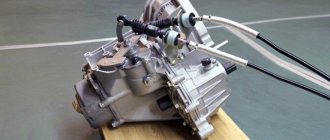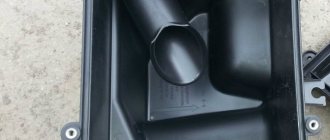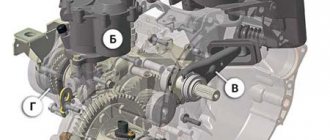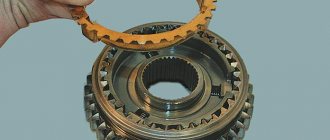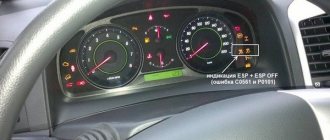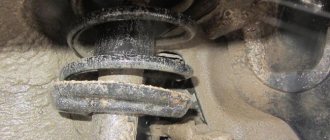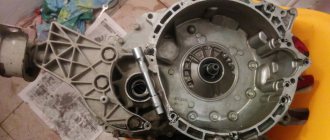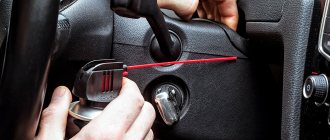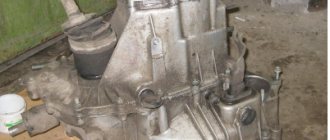Is it new and updated?
Structurally, the new gearbox has not changed at all. For its production, the same components are used as for the previous version. Only the firmware has changed, thanks to which the transmission has acquired new properties.
According to AvtoVAZ specialists, it is impossible to reflash the old version of the box. According to them, the firmware process itself does not take place at the factory. Domestic cars are equipped with ready-made control units stitched by ZF. Apparently, owners of the previous version of the “robot” will have to put up with its shortcomings. There is information that technically it is still possible to perform a flashing or add some options, but in this case the car is removed from warranty service, and the owner of the car takes full responsibility for the correct operation of the transmission. Thus, there is currently no opportunity to update the transmission at an official dealer and maintain the warranty on the car.
Theory
The box itself is made on the basis of VAZ's five-speed manual transmission, but is equipped with actuators from the German company ZF. It made its debut in 2014 on the Priora, and slowly made its way to Vesta, which needs “two-pedal” versions like air - the car competes with foreign cars, and their buyers do not like to change gears manually. And the twitchy robot no longer suited her status very well.
But in Tolyatti they didn’t sit idly by - they changed the firmware, experimented with the clutch, and a big update happened this year - they announced it along with the release of the Lada Vesta Cross sedan, but at the May test of such cars simply. it didn't turn out. Therefore, we had to wait until November. So what has changed?
In terms of hardware - nothing. But according to AMT project manager Vladimir Petunin, they are now continuing to work closely with the clutch supplier, Valeo, to select the optimal composition of the friction linings. They are produced right there, at the Valeo plant in Tolyatti, which supplies AvtoVAZ with its products.
Shift speed
AMT 2.0 has become significantly faster than its predecessor. Thanks to the use of advanced algorithms, even an inexperienced driver will be able to feel the difference. The new gearbox now reacts 30% faster to changes in engine speed and selects the desired gear. Improvements are felt both when accelerating and when decelerating the car.
Of course, there is no need to talk about smooth and imperceptible gear shifting yet. The driver and passengers feel jerks when the gearbox operates, but there are no such deep dips as in the previous firmware version. Due to more correct switching, fuel consumption has decreased, which cannot but please owners of a budget car.
What's on the road?
It doesn’t matter, the lack of a sports mode is not at all the main problem of this box. I take the keys to the Vesta Cross sedan with a 1.8 engine and the first thing I notice is that indeed, maneuvering in the parking lot has become easier, because you don’t need to constantly “push” the car with the gas pedal. True, with a very smooth start from a standstill, vibrations are felt - later they appeared in traffic jams, so it is better to let go of the car in front a little and then accelerate a little more intensely. Moreover, the 1.8 engine does not like very low speeds and shakes in convulsions.
Unfortunately, the longest traffic jam we found in the vicinity of Sochi was only 20 minutes, so it will be possible to test the durability of the updated AMT only in the multi-hour Moscow traffic jams before the New Year. And what made me happy is that even with sharp acceleration from a standstill, the shifts have become more comfortable for the driver and passengers; now you don’t have to nod your heads every time you change gears.
Things are best when driving on highways - I was surprised by the unexpectedly fast response when overtaking with the pedal to the floor (kick-down), when the gearbox drops a couple of steps at once. There was no trace left of the old fear (“will she switch or not?”). However, there is always the possibility of switching to manual mode - the electronics are trained to make throttle changes when switching to lower ones.
CreepingMode
The previous version of the robotic box upset car owners due to the lack of a so-called “creeping” mode. This function is implemented in the new version of the box. Now, in order to move away, you don’t need to press the gas. It is enough to release the brake, and the car begins to move smoothly. This feature is available for first, second and reverse gears.
It’s difficult to call the start of movement in creeping mode smooth. When you release the brake, the car vibrates noticeably. This indicates that the clutch discs are not closing correctly. You can get used to this feature quite quickly, but the flaw will negatively affect the service life of the transmission.
When the driver's door is open and the parking brake is raised, Creeping Mode is automatically disabled. This will allow inattentive drivers to avoid unpleasant situations.
One might assume that the introduction of a “creeping” mode makes it easier to start moving on an incline, but this is not the case. Like Vesta with the previous version of the robot, the car with updated gearbox firmware rolls back. When you release the brake, the electronics select the desired gear, engage it and begin smooth movement. This happens for a relatively short time, but even a second delay is enough for the car to roll back. When starting on a hill, you need to quickly switch your foot from the brake to the gas, so the “robot” works faster.
Let's crawl out of here
I notice changes almost immediately after leaving the editorial gates. How I missed the “crawling” Creeping Mode during all two and a half years of living together with Vesta! Especially when parking in a confined space in winter, when there is ice under the wheels. The car started to move only after pressing the gas. Now the robot acts like a classic automatic machine: for the car to move, you just need to release the brake pedal. Moreover, there is enough traction to overcome the speed bump, to which the front wheels are located close, from a standstill without pressing the gas. This means that the robot can handle winter snow and ice mounds in the yard.
Vesta does not start as quickly as cars with classical hydromechanics. The box thinks for a second, then slowly engages the gear, and only after that does the movement begin. I noticed only one problem with the robot version 2.0: the car starts moving, making the engine tremble, as if an inexperienced driver had not yet gotten used to the manual gearbox. On the one hand, this is understandable. In the “creeping” mode, there is no need for high engine speeds; the car must move off very smoothly, without jerking, so it is necessary to smoothly close the clutch discs with minimal gas supply. The electronics are trying, but you need to operate the clutch even more gently. The shaking is not very pleasant, and such treatment is not good for the units. Therefore, when jostling in a traffic jam, it is better not to twitch once again, “creeping” 20–30 centimeters. And when maneuvering in the yard and in the parking lot, the “creeping” mode is just right!
Vesta can crawl both forward and backward. The speed supported by the automatic transmission depends on the gear engaged. On the first it is 7–8 km/h, on the second – 14–15 km/h, on the rear – 5–6 km/h. Foolproof protection is provided: the mode is turned off if you put the car on the parking brake or open the driver's door. I checked it - it works properly.
On the editorial Vesta, the algorithm of the hill start assist system is a little annoying. After releasing the brake pedal, the brake mechanisms hold the car from rolling back for a couple of seconds so that the driver has time to calmly move his foot from the brake to the gas. The function is configured in such a way that the automation “does not see” small slopes and therefore does not work. For all the time that Vesta has been rolling off the assembly line, this “anti-rollback” feature has not been cured - Vesta with the updated robot also moves backwards when starting up a hill. And you shouldn’t rely on the “creeping” mode: when you release the brake, the automatic system engages first gear more slowly than at the command from the accelerator pedal - the car has time to roll back. So, in a traffic jam on a slight rise, you will have to use the old scheme to speed up the car with the gas pedal.
Winter mode
The previous version of the robotic gearbox created a number of difficulties for the driver during icy conditions. The new AMT 2.0 has the ability to start from second gear. This allows you to start moving without slipping even on slippery roads. To start moving, you need to use the gas pedal; the creeping mode will not be enough, but in general the function works quite correctly and makes life easier.
To get underway on slippery surfaces, second gear will have to be engaged manually; there is no automatic winter mode in the robotic gearbox.
Acceleration dynamics
The acceleration time from 0 to 100 km/h remained virtually unchanged after the flashing. The robotic box is adapted for measured movement around the city. For fans of aggressive driving, this is not the best option. It should be noted that when you press the accelerator pedal sharply, the updated robot begins to respond much faster than the previous version, but you should not expect anything supernatural from this transmission. It is significantly inferior to the classic automatic and variator.
Typical problems
The Creeping Mode in the new “robot” is imperfect. When starting to move, a fairly pronounced vibration is felt, reminiscent of the result of the actions of a novice driver in a manual car. It is difficult to say what the average clutch life is, taking into account this feature, because the transmission has only recently entered into service.
When a loaded vehicle moves uphill, clutch slippage is sometimes noted and an error warning is displayed on the instrument panel. This is not critical and does not interfere with movement, but it also reduces the service life of the clutch.
AMT 2.0 service
According to the manufacturer's recommendations, the robotic gearbox does not require an oil change. But in practice everything is different. Experience shows that over time, transmission oil becomes contaminated and changes its viscosity. This negatively affects its ability to protect parts from wear. Auto mechanics recommend changing the oil at least every 75,000 miles. This will significantly increase the service life of the gearbox.
Most car owners note that after changing the oil, the transmission began to operate quieter, and jerking when driving became less pronounced. Changing the oil is not difficult, so do not neglect this procedure.
At the factory, the gearbox is filled with semi-synthetic oil TM-4-12 SAE 76W-85 GL-4 . It is suitable for most regions of our country and is all-season. When replacing, you can use both native oil and semi-synthetic ZIC G-FF 75W-85 . You should not strive to purchase the most expensive gear oil; it may not be suitable for the AMT 2.0 gearbox and lead to premature failure. Follow the manufacturer's recommendations.
conclusions
Undoubtedly, the updated “robot” AMT 2.0 is a breakthrough. It is more adequate and pleasant to use than the previous version. For lovers of measured driving, this is a comfortable, reliable solution. The new gearbox is unpretentious in maintenance, allows you to reduce fuel consumption and feel confident even on slippery road surfaces. Compared to a CVT or automatic, the “robot” installed on the Lada Vesta is significantly inferior in its characteristics, but this budget option will find its admirers.
Just the other day a new Lada Brand Day festival was organized in Sochi. The highlight of the program that day was the updated robotic gearbox. And since this unit is one of the most important in the design of the Lada Vesta and other models, it is absolutely impossible to bypass it!
Why was a robot needed at all?
AvtoVAZ strives to be in trend and follows global trends. This was the answer to this question from the company's management at all major press conferences. But in fact, everyone understands that Lada developed its “own” robot far from wanting to be in trend. The company created a gearbox that would replace the Japanese Aisin automatic, which turned out to be too expensive after the ruble exchange rate jumped. This is a banal saving, which today leads to increased costs of money on the part of car buyers.
There are several real factors that influenced the appearance of the robot as a whole:
- an increase in the price of the machine gun, since the company bought it in dollars and installed it on assembled cars; the Japanese assembled the machine guns and ensured a very high quality of their design;
- the four-speed automatic no longer looked modern, something more relevant, dynamic and fashionable was needed, which was the solution for the robot with its interesting design;
- it was necessary to come up with something Russian so that domestic cars would become more their own, less dependent on currency fluctuations and other unpleasant economic effects;
- this way the company concentrated more financial flows in its hands, was able to invest more money in its own developments and benefit financially in the end from all innovations;
- it is necessary to somehow improve the image of the corporation, and the new development came in handy to improve the perception of AvtoVAZ on the Russian market, as well as to enter the markets of other countries.
These are the multifaceted reasons for the introduction of this new product, from which ordinary buyers did not benefit, but the plant benefited. Of course, it would be better to have an Aisin automatic under the hood, which will last longer than the domestic engine. But Lada is still promoting its own development, which costs much less. Therefore, there is no point in hoping for major improvements in technology in the near future. You'll have to get used to the robot or just take the mechanics and not know grief with it.
We invite you to watch a video review of the features of the machine with robot 2.0:
Comments by Vladimir Petunin
It all started with an interview given to the Za Rulem publication by Vladimir Petunin, who, in fact, heads the AMT project.
He noted that the robotic transmission was created with the support of German companies. In this case, the main partner was ZF, while Porsche Engineering was a co-partner. In particular, Porsche Engineering was responsible for the basic tuning of the AMT.
After that, 4 years have passed, during which AvtoVAZ representatives closely monitored the operation of the gearbox, and special attention was paid specifically to complaints from owners of cars equipped with such a gearbox.
And so, having accumulated the required amount of data, AvtoVAZ modernized the transmission, and the lion's share of the adjustments falls on the unit control program.
Device
It consists of several main components:
- Manual transmission with clutch (dry or wet)
- Control and switching drives. Can be electric, hydraulic
- Electronic unit (brain). The robot's operating characteristics depend on its settings and software.
Clutch
A dual-clutch transmission such as a DSG can be used to deliver full power and driver comfort. But all AMT gearboxes are based on a manual transmission.
For example: BMW uses a 6-speed manual transmission with an electro-hydraulic type.
Control drives
As mentioned above, there are two types of clutch actuators: electric and hydraulic . The first type uses electric motors, the second type uses hydromechanical pistons and cylinders with valves.
AMT robotic boxes with electric drives differ from their counterparts in their low switching speed: 0.3-0.5 seconds. In this case, less energy is spent. In hydraulic drives, the opposite is true - high gear shift speeds, high energy consumption, and therefore higher fuel consumption.
Different types of cars use different types of controls. It all depends on what the engineers want from the car. Economy and low cost of the car - robot with electric drive, switching speed - hydraulics.
The “brains” of a robotic automatic transmission
The electronic control unit consists of:
- sensors,
- The block itself
- Control transfer bodies.
The sensors share information with the electronics about the speed of rotation of the crankshaft and drive axles, the temperature of the oil in the hydraulic drive, and the position of the gearbox selector handle. The electronics processes signals and transmits control commands to the electric drive, hydraulic valves, interacts with the engine, anti-lock braking system (ABS), ESP and other vehicle systems.
Changes
As AvtoVAZ engineers admit, there were no major modifications to the actuators in the design of the AMT Lada Vesta. Although, there are still some changes. The most noticeable thing is the presence of not one, but two boards in the control controller, and, naturally, new firmware.
IMPORTANT! This means that the owners of Lada Vesta with AMT, purchased before the update, WILL NOT be able to come to the dealer and simply update the firmware.
The designers have retained the Creeping mode option introduced this year, which drivers call “Traffic Mode”. If there is one, the driver just needs to take his foot off the brake pedal and Vesta will go. In this case, its speed will depend on the transmission:
- 1st gear – 7-8 km/h;
- 2nd gear – 14-15 km/h.
- Reverse gear – 5-6 km/h.
The Creeping mode option is automatically disabled if one of 3 conditions is met:
- Opening the driver's door while moving;
- Switching the AMT selector to N mode;
- Raising the parking brake handle.
This prevents the machine from moving spontaneously.
Those drivers who often drive with a full load, especially on serpentine roads, complained that the gearbox error indicator flashed on the dashboard. This occurs due to overheating, which causes the clutch to slip, to which the temperature sensor reacts. But this does not lead to the clutch discs opening.
IMPORTANT! This is not a breakdown, and therefore there is no need to stop using the machine. The corresponding instructions are in the instruction manual.
As a result of improvements to the Lada Vesta AMT, it is now possible to start driving at speed II when using manual mode. This was done to make starting on icy roads easier in winter.
It is also planned to introduce a Sport mode, the activation button for which will be on the dashboard. The Sport mode operates in automatic and manual modes. When you turn on Sport, the settings of the power unit and AMT of the Lada Vesta change.
IMPORTANT! Don't confuse Sport mode with Kick Down mode.
In addition, when manual mode is turned on, even at maximum speed, the box will hold the current gear.
Impression
After the event, Za Rulem journalists couldn’t help but test Vesta with the new AMT, and this time they got the Cross version. Based on the results of the tests, it was noted that while driving, the same pecks during switching that occurred previously were not observed.
In a traffic jam, the Creeping mode option appeared in all its glory, thanks to which the car does not have to “remind” each time by pressing the accelerator.
The car began to handle noticeably better on winding roads - the nervousness in driving disappeared. At the same time, gear changes are evident, but they are smoothed, which significantly increases comfort.
When you press the gas pedal to the floor, the LADA Vesta AMT immediately goes down 2 gears, which is much more efficient than before.
But there is no Sport mode yet, so I couldn’t test it.
As you can see, AvtoVAZ has made a big step forward in improving the Lada Vesta AMT. Now driving with such a transmission is much more pleasant.
